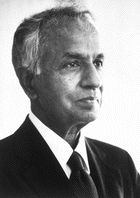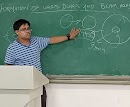Astronomy and Astrophysics
Chandrashekhar Limit and Tolman-Oppenheimer-Volkoff limit
In my article on electron degeneracy, I mentioned
about the Chandrashekar limit which was proposed by an Indian astrophysicist
Subrahmanyan Chandrashekhar at the age of 20 in 1930.
As I explained earlier that, white dwarfs resist
gravitational collapse through electron degeneracy. But after the Chandrashekhar
limit it cannot resist more.
Chandrashekhar limit is about 1.4 solar masses,
which is approximately 2.765 x 10^30 kg. Beyond this limit, the
star’s core cannot resist more and either forms a neutron star or a black hole
depending upon the mass.
Electron degeneracy pressure is a quantum-mechanical effect arising from
the Pauli exclusion principle. Since electrons are fermions, no two electrons can be in the same state, so not
all electrons can be in the minimum-energy level. Rather, electrons must occupy
a band of energy levels.
Compression of the electron gas increases the
number of electrons in a given volume and raises the maximum energy level in
the occupied band. Therefore, the energy of the electrons increases on
compression, so pressure must be exerted on the electron gas to compress it,
producing electron degeneracy pressure. With sufficient compression, electrons
are forced into nuclei in the process of electron capture, relieving the
pressure.
Mlimit = {(ωo3√3π)/2}
( c/G)^3/2{1/(µemH)}
Where,
ħ is the reduced Planck
constant
c is the speed of light
G is the gravitational constant
μe is
the average molecular weight per electron, which depends upon the
chemical composition of the star.
mH is the mass of
the hydrogen atom.
ωo3 ≈
2.018236 is a constant connected with the solution to the Lane–Emden
equation
Tolman-Oppenheimer-Volkoff limit
Just like the work done by Chandrashekhar Limit for
white dwarfs, Tolman-Oppenheimer-Volkoff limit do for Neutron stars. In neutron
stars, the gravitational collapse is stopped by Neutron Degeneracy which I
explained in my previous article. After this limit, even Neutron degeneracy
cannot stop further collapse and form black holes.
In upcoming articles, I am going to explain about formation of black holes and A detail analysis of Type 1a supernovae…….Once they are uploaded the link will be available here and also in my social handles.
So, don’t forget to subscribe to our website and follow me on social media for updates…..
To know more about bosons and fermions click here......
To know basics of quantum world, astronomy and space exploration you can check out my book "Through the wormhole" on amazon kindle.
You can directly talk with me on Instagram
To meet more physics Enthusiasts please join our Facebook Page
Also for latest updates of my posts join me on TwitterTo meet more physics Enthusiasts please join our Facebook Page
Thanks for reading.....
See you next time!!!
-Ratnadeep Das Choudhury
Founder and Writer of The Dynamic Frequency














0 Comments